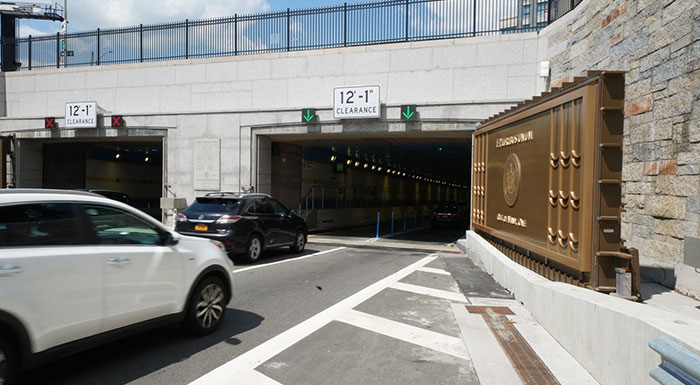Photo Courtesy of the Office of the Governor
Superstorm Sandy restoration work at the Midtown Tunnel was completed more than nine months ahead of schedule.
By Forum Staff
Restoration work at the Queens Midtown Tunnel and Hugh L. Carey Tunnel has been completed more than nine months ahead of schedule, Gov. Andrew Cuomo announced on Friday.
The two Superstorm Sandy projects “completely overhauled” the interiors and exteriors of the two tunnels—which were severely damaged by salt water from the storm surge—to improve resiliency, maximize public safety, and ease traffic flow, Cuomo noted.
During and after Sandy, Cuomo and MTA Chairman Joe Lhota toured the tunnels and saw the damage left in the wake of the historic near-9.5-foot storm surge that flooded the Carey Tunnel with 60 million gallons of contaminated salt water and the Midtown Tunnel with roughly 12 million gallons of flood water. The salt water severely damaged all tunnel systems including electrical, lighting, communication, traffic controls, drainage and finishes.
According to the State, Metropolitan Transportation Authority Bridges & Tunnels implemented long-term mitigation measures including installing massive 50,000-pound steel flood gates at all tunnel portals to protect against a Federal Emergency Management Agency 500-year flood event—four feet higher than the Sandy historic storm surge—as well as refurbished entryways. New state-of-the-art traffic control, communication, and drainage systems also were installed on the interiors of the tunnels. Roadway lighting was replaced with new energy efficient LED lighting, and new tiles, fire-rated ceiling boards, drainage gutters, pavement and catwalks were added. Plaza walls were restored and decluttered, removing conduits and unveiling original granite.
“Superstorm Sandy was a wakeup call about the urgency to rebuild better, stronger and more resilient,” Cuomo said. “We undertook an unprecedented and expedited transformation of these two iconic tunnels and in the process modernized New York’s infrastructure with cashless tolling—saving drivers millions of hours of travel time and creating a transportation system fit for the 21st century.”
The governor also noted that both projects also included several public safety enhancements. Radiation detection equipment has also been installed at each tunnel entrance, and facial recognition equipment is currently being tested at the Robert F. Kennedy Bridge. Situational awareness and security cameras have been installed at each tunnel entrance, including fixed cameras for traffic monitoring and incident management monitored by the Triborough Bridge and Tunnel Authority’s Operations Command Center. Pan, tilt and zoom cameras that automatically move to capture potential security issues as part of TBTA’s Electronic Security System were also added. In addition, 37 trucks—each weighing 10-tons and operated by the National Guard—are strategically deployed at all MTA crossings and ready to intercept possible security threats or terrorist attacks.
The two tunnel restoration projects totaled more than $550 million and were largely funded by FEMA. To minimize impacts to the travelling public, all restoration work was integrated with other planned rehabilitation work as well as with the implementation of cashless tolling at both tunnels and the replacement of the decaying Morris Street pedestrian bridge at the Carey Tunnel.
“With historic commitments, we are better, stronger, more competitive, and more resilient to weather any storms that may come our way,” Queens Borough President Melinda Katz said on Friday.

